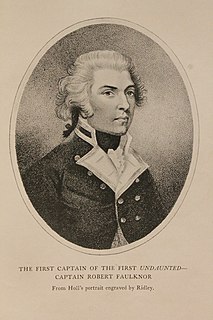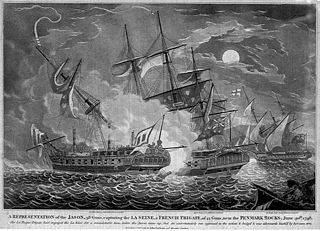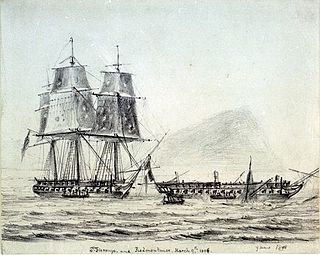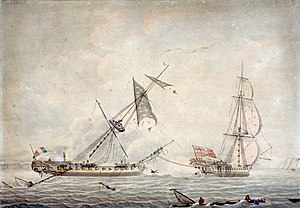
HMS Indefatigable was one of the Ardent-class 64-gun third-rate ships-of-the-line designed by Sir Thomas Slade in 1761 for the Royal Navy. She was built as a ship-of-the-line, but most of her active service took place after her conversion to a 44-gun razee frigate. She had a long career under several distinguished commanders, serving throughout the French Revolutionary Wars and the Napoleonic Wars. She took some 27 prizes, alone or in company, and the Admiralty authorised the issue of four clasps to the Naval General Service Medal in 1847 to any surviving members of her crews from the respective actions. She was broken up in 1816.

HMS Babet was a 20-gun sixth-rate post ship of the British Royal Navy. She had previously been a corvette of the French Navy under the name Babet, until her capture in 1794, during the French Revolutionary Wars. She served with the British, capturing several privateers and other vessels, and was at the Battle of Groix. She disappeared in the Caribbean in 1800, presumably having foundered.

Minerve was a 40-gun Minerve-class frigate of the French Navy. The British captured her twice and the French recaptured her once. She therefore served under four names before being broken up in 1814:

HMS Zebra was a 16-gun Zebra-class sloop of the Royal Navy, launched on 31 August 1780 at Gravesend. She was the second ship to bear the name. After twenty years of service, including involvement in the West Indies campaigns during the French Revolutionary Wars, she was converted into a bomb vessel in 1798. In this capacity she took part in attacks on French ports, and was present at both battles of Copenhagen. The Navy sold her in 1812.

Robert Faulknor the younger (1763–1795) was an 18th-century Royal Navy officer, part of the Faulknor naval dynasty. He was court-martialled and died in an action off Guadeloupe in the eastern Caribbean Sea.

Révolutionnaire, was a 40-gun Seine-class frigate of the French Navy, launched in May 1794. The British captured her in October 1794 and she went on to serve with the Royal Navy until she was broken up in 1822. During this service Revolutionnaire took part in numerous actions, including three for which the Admiralty would in 1847 award clasps to the Naval General Service Medal, and captured several privateers and merchant vessels.
Coquille was a 40-gun frigate of the French Navy, lead ship of her class, and launched in 1794. The Royal Navy captured her in October 1798 and took her into service as HMS Coquille, but an accidental fire destroyed her in December 1798.

HMS Mermaid was a 32-gun Active-class fifth-rate frigate of the Royal Navy, launched in 1784 and broken up in 1815. During the French Revolutionary Wars she served in the West Indies, the Channel, and the Mediterranean. During the Napoleonic Wars she first served in the Americas, but from early 1811 on, she was armed en flute and served as a troopship until she was broken up.

HMS Jason was a 38-gun Artois-class fifth-rate frigate of the Royal Navy. She served during the French Revolutionary Wars, but her career came to an end after just four years in service when she struck an uncharted rock off Brest and sank on 13 October 1798. She had already had an eventful career, and was involved in several engagements with French vessels.

Seine was a 38-gun French Seine-class frigate that the Royal Navy captured in 1798 and commissioned as the fifth-rate HMS Seine. On 20 August 1800, Seine captured the French ship Vengeance in a single ship action that would win for her crew the Naval General Service Medal. Seine's career ended in 1803 when she hit a sandbank near the Texel.

HMS Vengeance was originally the 48-gun French Navy frigate Vengeance and lead ship of her class. She engaged USS Constellation during the Quasi-War, in an inconclusive engagement that left both ships heavily damaged. During the French Revolutionary Wars, HMS Seine hunted Vengeance down and captured her after a sharp action. She was recommissioned in the Royal Navy as the 38-gun fifth rate HMS Vengeance, but the British apparently never returned her to seagoing service. Accounts are divided as to her eventual fate. She may have been broken up in 1803 after grounding in 1801, or continued as a prison ship until 1814.

Minerve was a 40-gun frigate of the French Navy, lead ship of her class. She operated in the Mediterranean during the French Revolutionary Wars. Her crew scuttled her at Saint-Florent to avoid capture when the British invaded Corsica in 1794, but the British managed to raise her and recommissioned her in the Royal Navy as the 38-gun fifth rate HMS St Fiorenzo.

HMS Blanche was a 32-gun Hermione-class fifth rate of the Royal Navy. She was ordered towards the end of the American War of Independence, but only briefly saw service before the outbreak of the French Revolutionary Wars in 1793. She enjoyed a number of successful cruises against privateers in the West Indies, before coming under the command of Captain Robert Faulknor. He took the Blanche into battle against a superior opponent and after a hard-fought battle, forced the surrender of the French frigate Pique. Faulknor was among those killed on the Blanche. She subsequently served in the Mediterranean, where she had the misfortune of forcing a large Spanish frigate to surrender, but was unable to secure the prize, which then escaped. Returning to British waters she was converted to a storeship and then a troopship, but did not serve for long before being wrecked off the Texel in 1799.
Charles Inglis was an officer of the Royal Navy who saw service during the French Revolutionary and Napoleonic Wars, rising to the rank of post-captain.
Frederick Watkins was an officer of the British Royal Navy.
Seven ships of the French Navy have borne the name Sans-Culotte in honour of the Sans-culottes:

The action of 30 June 1798 was a minor naval engagement fought along the Biscay coast of France during the French Revolutionary Wars. The French Navy had been largely driven from the Atlantic Ocean early in the war following heavy losses in a series of failed operations. This had allowed the Royal Navy's Channel Fleet to institute a close blockade on the French naval ports of the Biscay coast, particularly Brest in Brittany. The blockade strategy included a constantly patrolling inshore squadron composed of frigates, tasked with preventing the passage of French ships into or out of the port. In the spring of 1798, several French frigates stationed in the Indian Ocean were sent back to France as the base at Île de France could no longer supply them effectively. One of these ships was the 40-gun frigate Seine, which departed Port Louis laden with 280 soldiers from the garrison.
Sir William Cunningham Dalyell of the Binns, 7th Baronet was an officer in the British Royal Navy who served in the French Revolutionary Wars and in the forces under Sir Sidney Smith that operated along the French and Dutch coasts during the Napoleonic Wars. Born on 27 April 1784 in Linlithgowshire, Scotland, his father was Sir Robert Dalyell of the Binns, 4th Baronet, an officer in the British Army. William inherited the title 7th Baronet in 1851 when his brother died.
The French brig Observateur, which was launched in 1800 for the French Navy, was a Vigilant-class 16-gun brig, one of six built to a design by Pierre-Alexandre-Laurent Forfait. The Royal Navy captured her in 1806 and took her into service as HMS Observateur. She participated in two actions, one for the French Navy and one for the Royal Navy, and one campaign before she was laid up in 1810. The Navy did not succeed in selling her until 1814.

HMS Triton was a 32-gun fifth-rate frigate of the Royal Navy designed by James Gambier and launched in 1796 at Deptford. Triton was an experimental ship and the only one built to that design; she was constructed out of fir due to wartime supply shortages of more traditional materials and had some unusual features such as no tumblehome. Her namesake was the Greek god Triton, a god of the sea. She was commissioned in June 1796 under Captain John Gore, with whom she would spend the majority of her active service, to serve in the Channel in the squadron of Sir John Warren.












